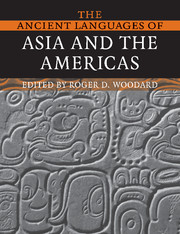Book contents
- Frontmatter
- Contents
- List of figures
- List of tables
- List of maps
- List of contributors
- Notes on numbering and cross-referencing
- List of abbreviations
- Preface
- Preface to the first edition
- 1 Language in ancient Asia and the Americas: an introduction
- 2 Sanskrit
- 3 Middle Indic
- 4 Old Tamil
- 5 Old Persian
- 6 Avestan
- 7 Pahlavi
- 8 Ancient Chinese
- 9 Mayan
- 10 Epi-Olmec
- Appendix 1 Reconstructed ancient languages
- Appendix 2 Full tables of contents from The Cambridge Encyclopedia of the World's Ancient Languages, and from the other volumes in the paperback series
- Index of general subjects
- Index of grammar and linguistics
- Index of languages
- Index of named linguistic laws and principles
10 - Epi-Olmec
Published online by Cambridge University Press: 01 September 2010
- Frontmatter
- Contents
- List of figures
- List of tables
- List of maps
- List of contributors
- Notes on numbering and cross-referencing
- List of abbreviations
- Preface
- Preface to the first edition
- 1 Language in ancient Asia and the Americas: an introduction
- 2 Sanskrit
- 3 Middle Indic
- 4 Old Tamil
- 5 Old Persian
- 6 Avestan
- 7 Pahlavi
- 8 Ancient Chinese
- 9 Mayan
- 10 Epi-Olmec
- Appendix 1 Reconstructed ancient languages
- Appendix 2 Full tables of contents from The Cambridge Encyclopedia of the World's Ancient Languages, and from the other volumes in the paperback series
- Index of general subjects
- Index of grammar and linguistics
- Index of languages
- Index of named linguistic laws and principles
Summary
HISTORICAL AND CULTURAL CONTEXTS
The Epi-Olmec language is the most ancient attested member of the Mije-Sokean family (c. 300 BCE to at least 533 CE). This family and its internal relationships are presented in Figure 10.1. In the sixteenth century, this family occupied a continuous area of southern Mesoamerica, extending from southern Veracruz to the border of present-day Guatemala, and with no trace of other native languages apart from islands of Nawa. The region seems to have been exclusively Mije-Sokean until the invasion of these Nawas, sometime between 600 and 900 CE; they influenced the vocabularies of individual Mije-Sokean languages but not that of Proto-Sokean or Proto-Mijean.
This region included the entire heartland of the Olmec civilization (1500–500 BCE), and the above circumstances provide a prima facie case that the Olmecs were Mije-Sokeans. Olmecs had widespread influence, diffusing innovations that would become distinctively Mesoamerican cultural characteristics. Evidence from associated linguistic diffusion con-firms that at least some Olmecs spoke an early Mije-Sokean language (Campbell and Kaufman 1976); further analysis suggests to us that they were Sokean specifically.
Olmec civilization was originally defined by its distinctive art style, which developed in situ in the Olmec heartland, and whose classic form ended after the abandonment of La Venta (c. 500 BCE).
- Type
- Chapter
- Information
- The Ancient Languages of Asia and the Americas , pp. 193 - 233Publisher: Cambridge University PressPrint publication year: 2008
- 3
- Cited by

